Stay updated on news, articles and information for the rail industry
4/22/2021
Rail News: Union Pacific Railroad
Union Pacific reports lower profit, revenue in Q1

Union Pacific Corp. today reported first-quarter 2021 net income of $1.3 billion, or $2 per diluted share, compared with $1.5 billion, or $2.15 per diluted share, during the same period a year ago.
The Class I’s operating revenue of $5 billion declined 4% during the quarter. Business volumes, as measured by total revenue carloads, fell 1% compared to Q1 2020 due to declines in industrial and bulk shipments, partially offset by strength in premium carloads.
The quarter presented "some real challenges that impacted our results," said Lance Fritz, UP's chairman, president and chief executive officer.
"We generated solid productivity through efficient use of our resources despite the significant weather event that covered most of our network in February and early March," Fritz said in a press release. "Looking to the rest of the year, an improving economic outlook, our continued commitment to value based pricing that exceeds inflation and the opportunity for strong productivity give us confidence to affirm our 2021 guidance."
UP reported a Q1 operating ratio of 60.1%, up from 59% last year. The increase was attributed to weather and rising fuel prices.
Quarterly freight revenue declined 5%, as core pricing gains were more than offset by a less favorable business mix, decreased fuel surcharge revenue and volume declines.
Also during the quarter, UP's “service product and lower cost structure” attracted new business and growth opportunities, Fritz said.
"There are many more growth opportunities to capture by also helping our customers efficiently and reliably reduce the carbon intensity of their supply chains," he said.


 2025 MOW Spending Report: Passenger-rail programs
2025 MOW Spending Report: Passenger-rail programs
 Gardner steps down as Amtrak CEO
Gardner steps down as Amtrak CEO
 Guest comment: Oliver Wyman’s David Hunt
Guest comment: Oliver Wyman’s David Hunt
 Women of Influence in Rail eBook
Women of Influence in Rail eBook
 railPrime
railPrime








